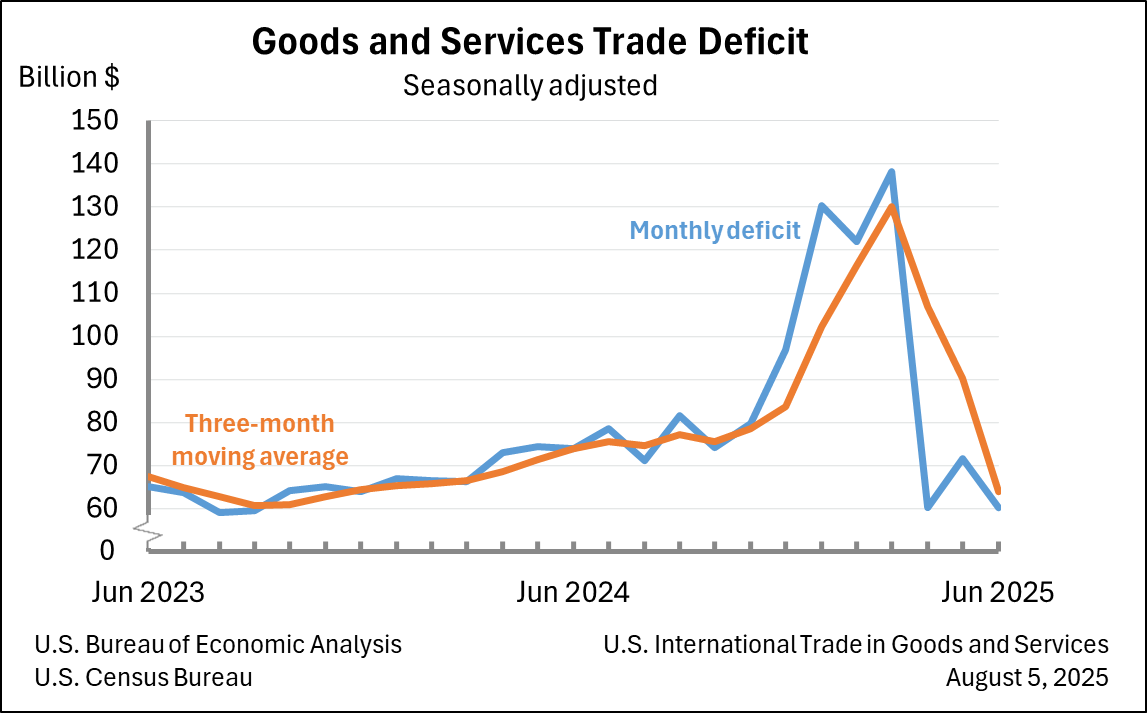Bureau of Economic Analysis
U.S. International Trade in Goods and Services, June 2025
The U.S. goods and services trade deficit decreased in June 2025 according to the U.S. Bureau of Economic Analysis and the U.S. Census Bureau. The deficit decreased from $71.7 billion in May (revised) to $60.2 billion in June, as exports decreased less than imports. The goods deficit decreased $11.4 billion in June to $85.9 billion. The services surplus increased $0.1 billion in June to $25.7 billion.
Principal Federal Economic Indicators
Noteworthy
- 2025 News Release Schedule
- Innovation at BEA
- 2025 Annual Updates
- Distribution of Personal Income Nowcast
- New! Services Trade Data for More Countries
- Data Tool: Trade in Value Added
- Updated: RIMS II Regional Multipliers
- Arts and Culture
- Space Economy
- FDI Now in State BEARFACTS
- Quick Guide: Price Indexes
The Latest
Gross Domestic Product, 3rd quarter 2012 (second estimate); Corporate Profits, 3rd quarter 2012 (preliminary estimate)
Real gross domestic product -- the output of goods and services produced by labor and property located in the United States -- increased at an annual rate of 2.7 percent in the third quarter of 2012 (that is, from the second quarter to the third quarter), according to the "second" estimate released by the Bureau of Economic Analysis. In the second quarter, real GDP increased 1.3 percent. The GDP estimate released today is based on more…
Personal Income Rose in Most Counties in 2011
Personal income rose in 3,062 of the nation’s 3,113 counties in 2011, with growth ranging from 62.2 percent in King County, TX, to –28.8 percent in Lynn County, TX. Of the 50 counties with the fastest personal income growth in 2011, 45 were located in the Plains Region—with 41 of the 45 counties located in Nebraska, North Dakota, and South Dakota. Increases in farm income were a major factor in the growth rates for most of these…
Personal Income Rose in All 366 Metro Areas in 2011
Personal income rose in 2011 in all of the nation’s 366 metropolitan statistical areas (MSAs) for the first time since 2007. Personal income growth ranged from 14.8 percent in Odessa, TX, to 1.0 percent in Rochester, MN. Personal income in the United States rose 5.2 percent in 2011, up from 3.8 percent in 2010. Inflation, as measured by the national price index for personal consumption expenditures, accelerated to 2.4 percent in 2011…
Local Area Personal Income, 2009-2011
Personal income rose in 2011 in all of the nations 366 metropolitan statistical areas (MSAs) for the first time since 2007, according to estimates released today by the U.S. Bureau of Economic Analysis. Personal income growth ranged from 14.8 percent in Odessa, Texas to 1.0 percent in Rochester, Minnesota. Personal income in the United States rose 5.2 percent in 2011, up from 3.8 percent in 2010. Inflation, as measured by the national price…
Growth in Goods and Services Industries Slowed in 2011
Retail trade and durable goods manufacturing were the leading contributors to the deceleration in U.S. economic growth in 2011, according to revised statistics on the breakout of real gross domestic product (GDP) by industry from the Bureau of Economic Analysis.
Revised Statistics of Gross Domestic Product by Industry, 2009-2011
Retail trade and durable goods manufacturing were the leading contributors to the deceleration in U.S. economic growth in 2011, according to revised statistics on the breakout of real gross domestic product (GDP) by industry from the Bureau of Economic Analysis. Real GDP growth slowed in 2011, increasing 1.8 percent after increasing 2.4 percent in 2010. The revised statistics do not change the general picture of the economy: 12 of 22…
The Use Table: An Essential Tool That Looks Deep Inside the U.S. Economy
What’s the foundation for many economic statistics both inside and outside the Bureau of Economic Analysis (BEA)? It’s something most people have never heard of, yet it is essential for finding out what’s going on inside the world’s largest economy. It’s called the “use table,” and it is a fundamental tool of BEA’s input-output accounts. The use table provides both a broad and a detailed look at the U.S. economy. It is simple, yet…
September 2012 Trade Gap is $41.5 Billion
The U.S. monthly international trade deficit decreased in September 2012, according to the U.S. Bureau of Economic Analysis and the U.S. Census Bureau. The deficit decreased from $43.8 billion (revised) in August to $41.5 billion in September, as exports increased more than imports. The previously published August deficit was $44.2 billion. The goods deficit decreased $1.4 billion from August to $57.5 billion in September, and the services…
New Guide Helps Regional Developers, Planners Navigate RIMS II
People who conduct or examine local or regional economic impact studies will want to read a new handbook that offers some dos and don’ts on using the Bureau of Economic Analysis (BEA) Regional Input-Output Modeling System (RIMS II).
RIMS II, a regional economic model, is most frequently used by investors, regional planners, and government officials to gauge the economy-wide impact of a change in economic activity on a local community…




